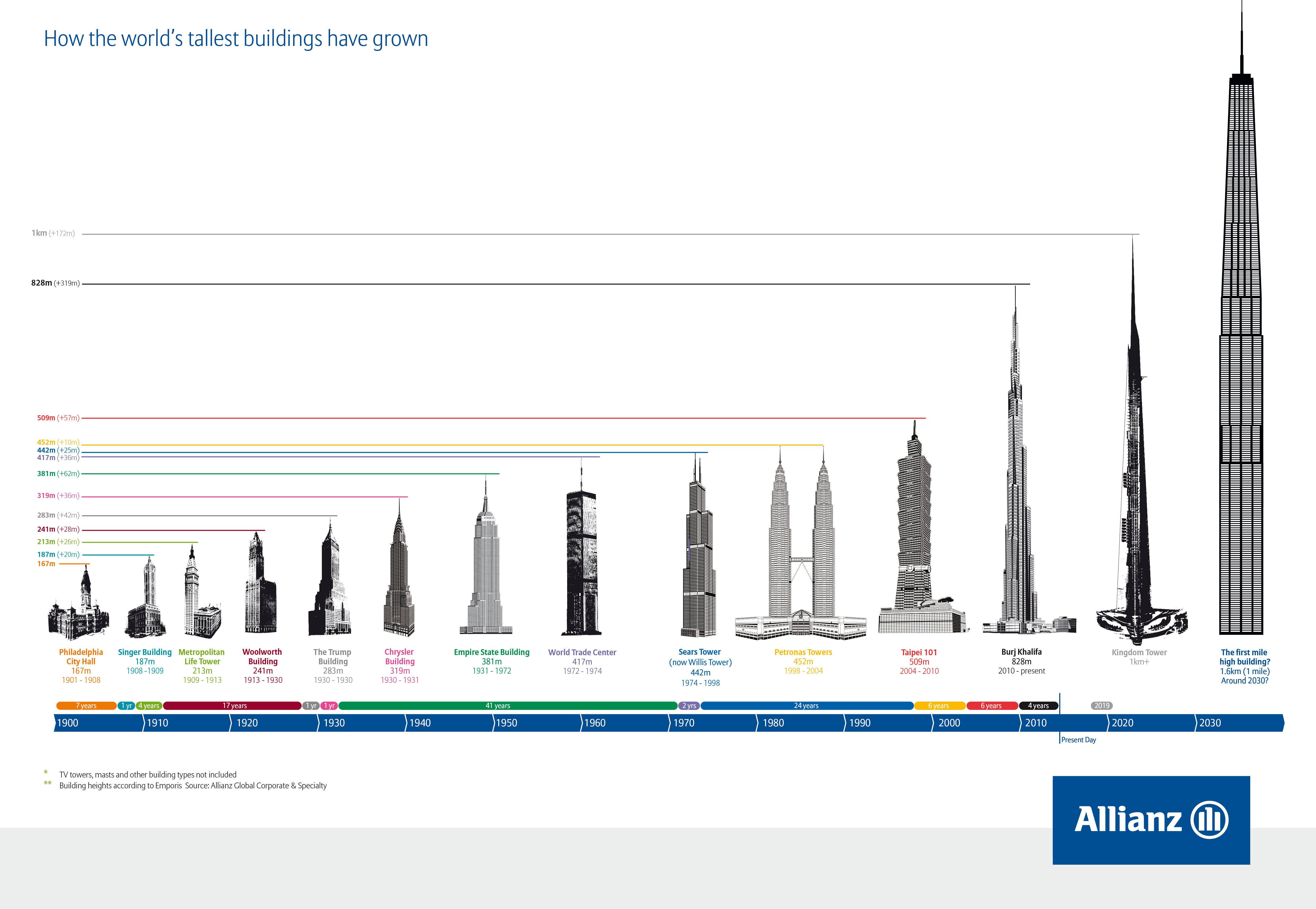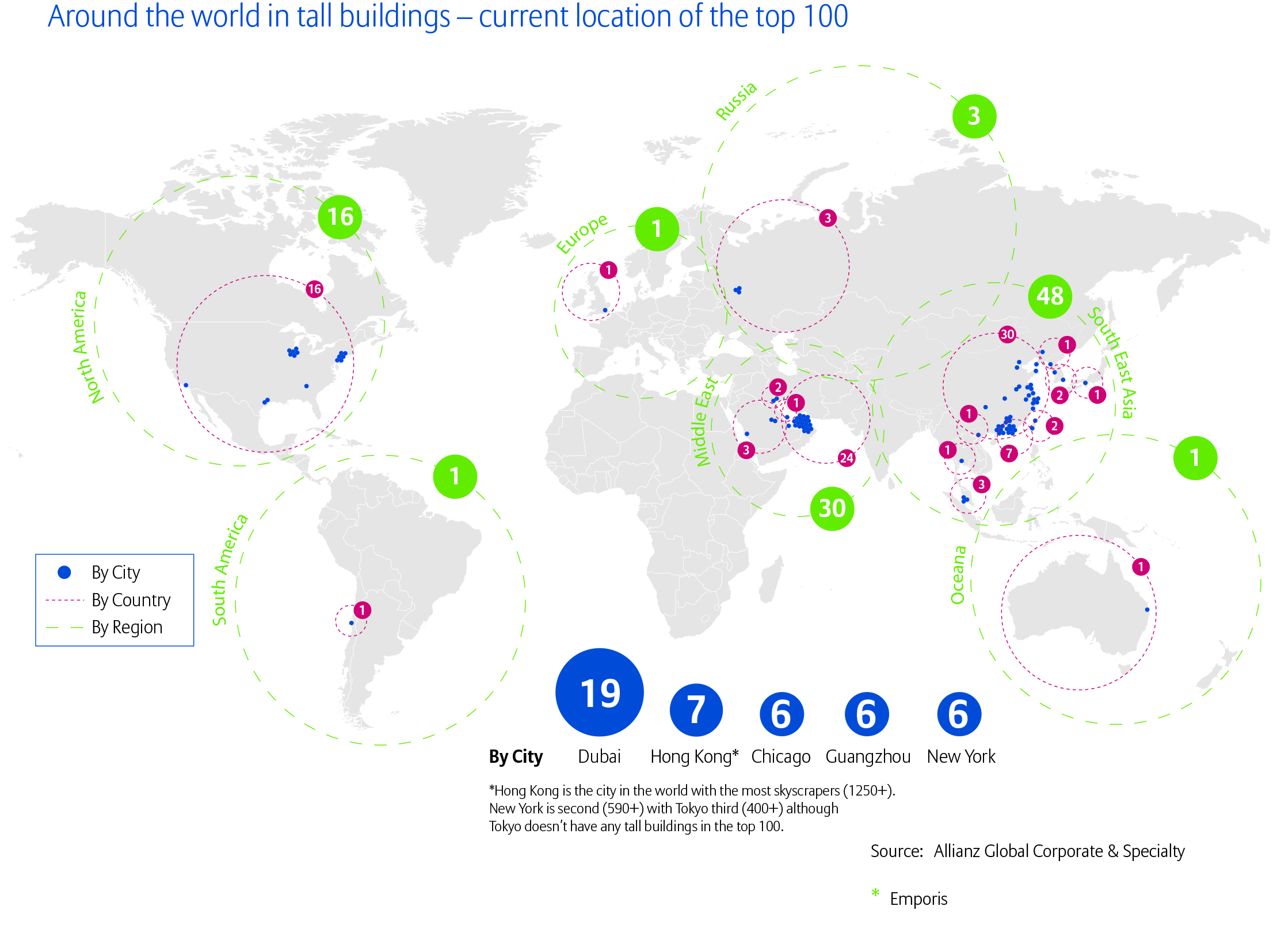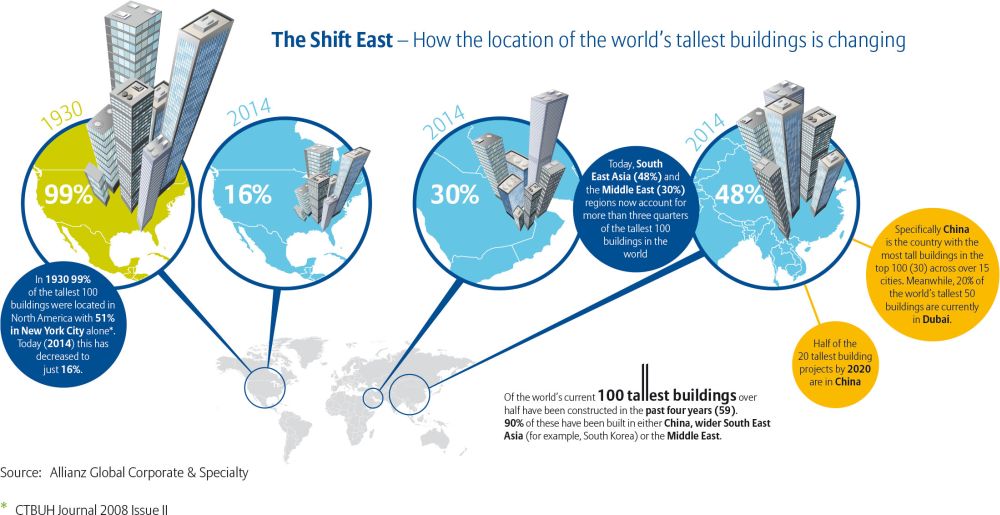Allianz Global Corporate Solutions is the reinsurer of themegascraper. Of the 100 tallest buildings in the world, Allianzinsurers every single one of them. This has become a definedspecialty for them, but there are still plenty of skyscrapers below100 stories that need coverage, and that are well tall enough toentail many of the same considerations of their taller brethrenwhen it comes to construction and underwriting.
|As AGCS has released its report, “Supertall Buldings,:Construction Risk Assessment in the 21st Century,” it covers manyof the particular challenges and opportunities of covering suchmonumental building projects. We have focused on just four of themost important. We will provide a link to the report at the end ofthis story. (For a closer look at the following graphic – and wesuggest that you do, because it is fascinating – click here to see a hi-res version.)
||Concentration of value
|Skyscrapers are getting taller than ever. The proposed KingdomTower in Jedda, Saudi Arabia, which will be the world's tallestbuilding once completed, at 3,280 feet. It will be the king of the“megascraper,” skyscrapers standing more than 2,000 feet tall.(Incredible to think that the Burj Kalifa will no longer be theworld's tallest, eh?).
|By 2020, the average total height of the tallest 20 buildings inthe world, will be around 2,000 feet. That is twice the height ofthe Eiffel Tower. Megascrapers might reach a height of one mile,but that won't be likely for another 20 or 30 years, as engineeringstruggles to find ways to make that a reality.
|But that is a radical advancement in a short period of time.Consider this: the Empire State Building, at just 1,250 feet tall,held the world's record for height for more than 40 years. Inperhaps only half as much time, the new limit will double, to morethan quadruple the Empire State Building's height.
|If that doesn't impress you, try this: As megascraper buildingexploded across the Middle East and Asia, the Taipei Tower held theworld's record from 2004-2010, standing at almost 1,700 feet. Whenthe Burj Khalifa was completed, it beat the record handily. Howhandily? Heightwise, it was like taking the Taipei Tower and thenstacking the Chrysler Building on top of it.
|With all this height comes value, and a concentration of risk.The average megascraper is a billion-dollar project, to say nothingof what value the building will have once it is fully opened forbusiness and occupied. Keep in mind that the insured losses of theWorld Trade Center were some $4.5 billion. The Kingdom Tower inJedda is looking to have an insured value of $1.5 billion.
|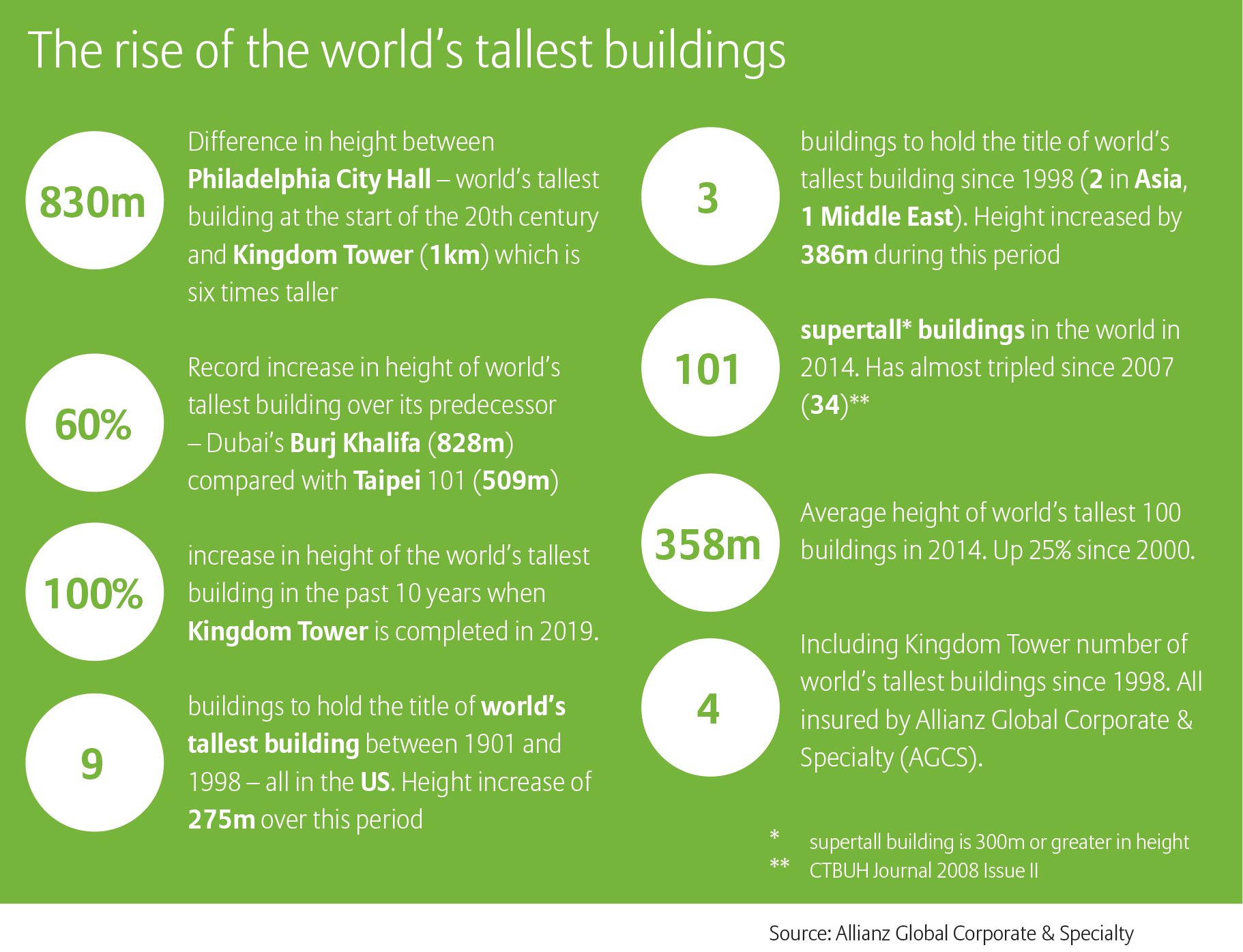
Technical limits
|Most skyscrapers hit a limit at 2,000 feet because that's as faras modern elevator technology extends. To build something tallerthan that, you need to start getting creative, and today'smegascrapers certainly are that. Most are not just ambitiouseconomic platforms and national prestige projects, but they arealso master classes in architectural and materials innovation. Atsuch heights, even steel and cement have their limits, and theremight not be enough alternate materials on hand to build with.
|Safety to the surrounding area is also a concern, with specialattention paid to damping systems that will reduce negative impactfrom wind or seismic activity. These are not off-the-shelfsolutions. The Taipei Tower, for example, uses 660-ton activependulum in the center of the building as a mass damper. The BurjKhalifa uses a “buttressed core” and a high-performance method ofwall construction to maintain its stability.
|Geological considerations must also be taken into consideration.Local geology is what is keeping the Kingdom Tower from getting anytaller. And you know how there are areas of Manhattan withoutskyscrapers? That's because the bedrock there simply won't supportthem.
||Risk factors
|Megascrapers involve a number of other special risks, not theleast of which is “solar gain” in which the massive amount ofsunlight and heat the building absorbs might reach locallydangerous levels.
|A supertall construction project can involve as many as 10,000workers and more than 100 subcontractors. Glass panels and concretemust be specially formualated to withstand the rigors of suchspecialized construction. As materials are lifted and craned tosuch extreme heights, wind speed becomes a significant safetyfactor – the play on the crane at the top of the Freedom Tower wasnearly six feet in either direction.
|Once supertall buildings are finished, then there are new risksto consider. The sheer weight of the building will eventuallyimpose elastic shortening on its components, for example. And thefire and evacuation requirements become formidable, with multipleuse such as hotels, restaurants, offices, shopping centers andresidential areas all within the same structure. The World TradeCenter evacuated in under an hour during the 9/11 attacks, but onlybecause it took several times longer when the buildings wereevacuated after the 1993 WTC bombing.
|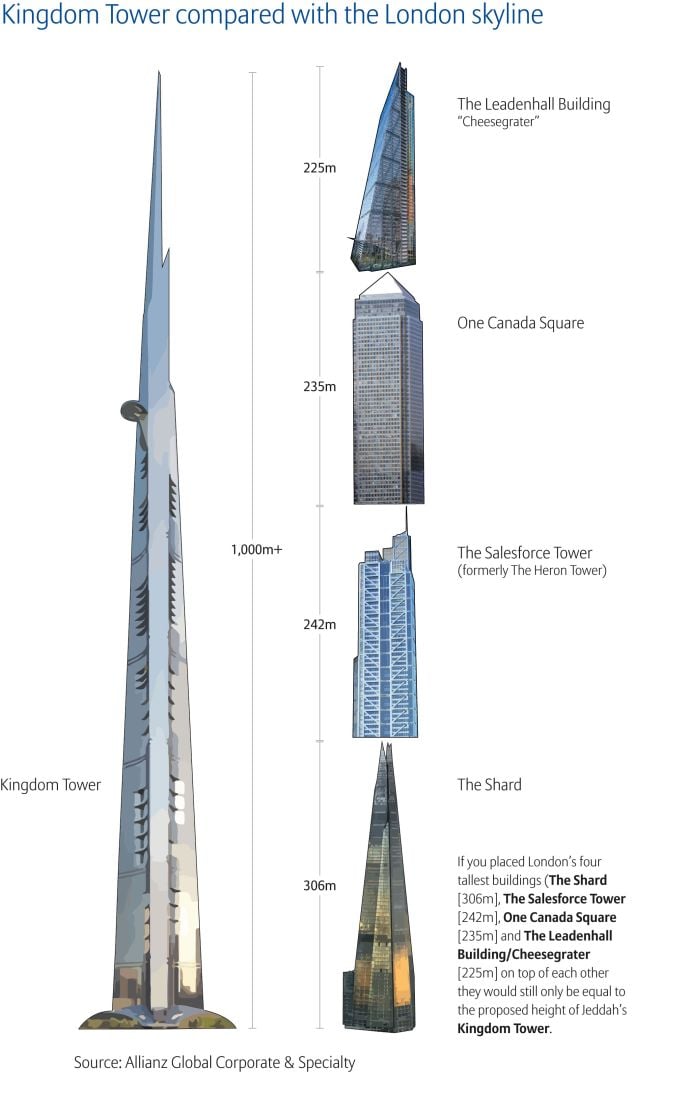
Market concentration
|If you're looking to insure the skyscrapers of tomorrow, lookoutside of the United States. All of the megascraper constructiongoing on these days is in the Middle East and in Asia, where thereis an appetite for creating massive flagship structures, and wherelabor costs are low enough to make these projects economicallyfeasible. The U.S. or Europe certainly have the capability tobuild the world's tallest building, but the cost of doing so wouldbe prohibitive.
|Of the world's 100 tallest buildings, 48 of them are inSoutheast Asia. 30 of them are in the Middle East. Another 30 arein China alone. North America, the birthplace of the modernskyscraper and home to some of the 20th century's most iconicskscrapers (and longest-running world record holders for height)has only 15.
|Of the world's tallest 50 buildings, 10 of those are in Dubai.Dubai is one of the megascraper capitals of the world. The recentlycompleted Freedom Tower in New York stands at an impressive 1,776feet tall, but it will be only half the height of the KingdomTower, once that building is completed.
|Given construction costs, regulatory oversight and a generalreluctance to build such enormous buildings (given the terrorismrisk they present), it is likely that the torch has passed out ofthe United States' and Europe's hands in terms of building theworld's tallest buildings for the foreseeable future. That said, itmight not be such a bad thing. Economists have noted that booms inskyscraper construction are linked to impending financialcrashes. Maybe Asia and the Middle East are creating a darkomen for themselves.
||* * *
|For more on insuring supertallbuildings, check out ACGS's report, which you can download here.
Want to continue reading?
Become a Free PropertyCasualty360 Digital Reader
Your access to unlimited PropertyCasualty360 content isn’t changing.
Once you are an ALM digital member, you’ll receive:
- All PropertyCasualty360.com news coverage, best practices, and in-depth analysis.
- Educational webcasts, resources from industry leaders, and informative newsletters.
- Other award-winning websites including BenefitsPRO.com and ThinkAdvisor.com.
Already have an account? Sign In
© 2024 ALM Global, LLC, All Rights Reserved. Request academic re-use from www.copyright.com. All other uses, submit a request to [email protected]. For more information visit Asset & Logo Licensing.


